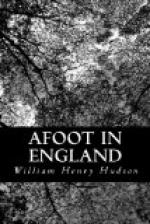It is not seriously contended that birds can be observed narrowly in this easy way; but even for the most conscientious field naturalist the wheel has its advantages. It carries him quickly over much barren ground and gives him a better view of the country he traverses; finally, it enables him to see more birds. He will sometimes see thousands in a day where, walking, he would hardly have seen hundreds, and there is joy in mere numbers. It was just to get this general rapid sight of the bird life of the neighbouring hilly district of Hampshire that I was at Newbury on the last day of October. The weather was bright though very cold and windy, and towards evening I was surprised to see about twenty swallows in Northbrook Street flying languidly to and fro in the shelter of the houses, often fluttering under the eaves and at intervals sitting on ledges and projections. These belated birds looked as if they wished to hibernate, or find the most cosy holes to die in, rather than to emigrate. On the following day at noon they came out again and flew up and down in the same feeble aimless manner.
Undoubtedly a few swallows of all three species, but mostly house-martins, do “lie up” in England every winter, but probably very few survive to the following spring. We should have said that it was impossible that any should survive but for one authentic instance in recent years, in which a barn-swallow lived through the winter in a semi-torpid state in an outhouse at a country vicarage. What came of the Newbury birds I do not know, as I left on the 2nd of November —tore myself away, I may say, for, besides meeting with people I didn’t know who treated a stranger with sweet friendliness, it is a town which quickly wins one’s affections. It is built of bricks of a good deep rich red —not the painfully bright red so much in use now—and no person has had the bad taste to spoil the harmony by introducing stone and stucco. Moreover, Newbury has, in Shaw House, an Elizabethan mansion of the rarest beauty. Let him that is weary of the ugliness and discords in our town buildings go and stand by the ancient cedar at the gate and look across the wide green lawn at this restful house, subdued by time to a tender rosy-red colour on its walls and a deep dark red on its roof, clouded with grey of lichen.
From Newbury and the green meadows of the Kennet the Hampshire hills may be seen, looking like the South Down range at its highest point viewed from the Sussex Weald. I made for Coombe Hill, the highest hill in Hampshire, and found it a considerable labour to push my machine up from the pretty tree-hidden village of East Woodhay at its foot. The top is a league-long tableland, with stretches of green elastic turf, thickets of furze and bramble, and clumps of ancient noble beeches—a beautiful lonely wilderness with rabbits and birds for only inhabitants. From the highest point where a famous gibbet stands for ever a thousand feet above the sea and where there




